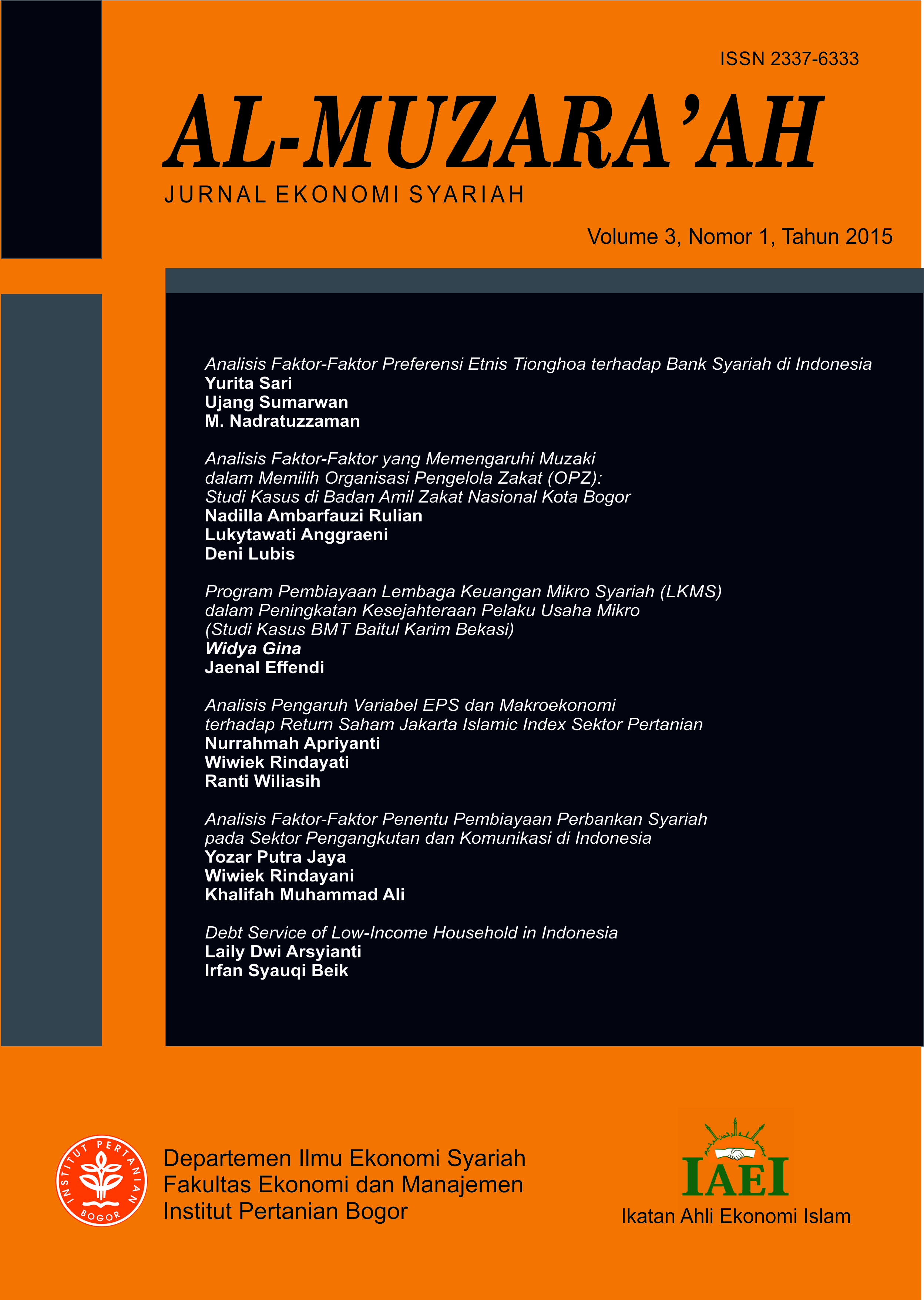Debt Service of Low-Income Households in Indonesia
Main Article Content
Abstract
Article Details
Section
Author(s) who published in this journal agree to following terms:
- Authors understand and agree that copyright of manuscripts published are held by Al-Muzara'ah. The statement to release the copyright to Al-Muzara'ah is stated in Copyright Transfer Agreement (CTA) form.
- Copyright encompass exclusive rights to reproduce, to distribute, and to sell any part of the journal articles in all form and media.
This work is licensed under a Creative Commons Attribution-ShareAlike 4.0 International License (CC BY-SA) where Authors and Readers can copy and redistribute the material in any medium or format, as well as remix, transform, and build upon the material for any purpose, but they must give appropriate credit (cite to the article or content), provide a link to the license, and indicate if changes were made. If you remix, transform, or build upon the material, you must distribute your contributions under the same license as the original.
References
Belsky ES, A Calder. 2005. Credit Matters: Building Assets in a Dual Financial Service System. Building Assets Building Credit: Creating Wealth in Low-Income Communities, pg.1-9. Washington: Brookings Institution Press.
Belsky ES, Retsinas NP. 2005. New Paths to Building Assets for the Poor. Building Assets Building Credit: Creating Wealth in Low-Income Communities, pg.1-9. Washington: Brookings Institution Press.
Brown, S, G Garino, K Taylor, SW Price. 2005. Debt and Financial Expectations: An Individual –and Household- Level Analysis. Economic Inquiry, Volume 43, Number 1, January 2005, page 100-120.
Cochran, W. G. 1977. Sampling Techniques (Third Eds). Canada: John Wiley and Sons Inc.
Gaberlavage G, S Hermanson. 2001. The Alternative Financial Services Industry. Washington: AARP Public Policy Institute.
Goode, J. 2012. Brothers are doing it for themselves?: Men’s experiences of getting into and getting out of debt. The Journal of Socio-Economics 41 (2012), page 327-335.
Lee, NR, M Miller. 2012. Influencing positive financial behaviors: the social marketing solution. Journal of Social Marketing. Volume 2, Issue 1, page 70-86.
Livingstone, S. M. and Lunt, P. K. 1992. Predicting personal debt and debt repayment: Psychological, social and economic determinants. Journal of Economic Psychology 13 (1992), 111-134.
Keese, M. 2012. Who feels constrained by high debt burdens? Subjective vs. Objective measures of household debt. Journal of Economic Psychology 33 (2012), 125-141.
M. Omar, M. 2011. Economic Consumption Model Revisited: Infak Model Based on Al-Shaybani’s Level of Kasb. International Journal of Economic, Management and Accounting, Volume (19), 2011. Supplementary Issues, pp. 115-132.
Mann D, C Narayanan, J Caparusso, P Chandra. 2013. Asia Leverage Uncovered. Standard Chartered Global Research: Strategic Collaborative Original Universal Thematic (SCOUT).
Mazlan N. 2014. An Investigation on Household Debt in Malaysia. http://www.inceif.org/research-bulletin/investigation-household-debt-malaysia/. INCEIF. Retrieved on August 19, 2014.
Meniago, C, J Mukuddem-Petersen, MA Petersen, IP Mongale. 2013. What Causes household debt to increase in South Africa?. Economic Modelling 22 (2013), page 482-492.
OECD. 2013. Household Debt. OECD Factbook 2013: Economic, Environmental and Social Statistics. OECD Publishing.
Oliveira, ACM, C Eckel, RTA Croson. 2012. The Stability of Social Preferences in a Low-Income Neighborhood. Southern Economic Journal 2012, 79 (1), page 15-45.
Omar, MM. 2011. Economic Consumption Model Revisited: Infaq Model Based on Al-Shaybani’s Level of Al-Kasb. International Journal of Economics, Management and Accounting, Volume 19, 2011, Supplementary Issues, page 115-132.
Plagnol, A. C. 2011. Financial satisfaction over the life course: the influence of assets and liabilities. Journal of Economic Psychology Vo. 32, No. 1, pp 45-64
Pressman, S, RH Scott III. 2009. Who are the Debt Poor?. Journal of Economic Issues, Volume XLIII, Number 2, June 2009, page 423-432.
Sahi, SK. 2013. Demographic and socio-economic determinants of financial satisfaction. International Journal of Social Economics, Volume 40, Issue 2, page 127-150.
Santoso W, M Sukada. 2009. Risk Profile of Household and the Impact on Financial Stability. BIS Papers No.46, 2009, pg.58-74.
Wright, K. 2001. Generosity vs. Altruism: Philanthropy and Charity in the United States and United Kingdom. Voluntas: International Journal of Voluntary and Nonprofit Organizations, Volume 12, Number 4, December 2001, page 399-416.

